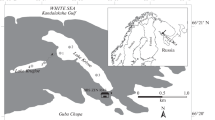Synopsis
The influence of temperature and the size of reproducing females on the timing of spawning of perch in Lake Geneva has been studied for 10 consecutive years (1984–1993) by means of artificial spawning substrates. The clutch of perch is an egg ribbon with a width proportional to the size of the reproducing female, so that the size structure distribution of the female population can be estimated from measurements of the width of the egg ribbons. The survey of egg-ribbon size revealed a succession of 3 cycles (period of increasing mean size followed by a sharp decrease) lasting 3, 3 and 4 years which were due to the occurrence of 3 strong year classes born in 1982, 1985 and 1988 respectively. This phenomenon can be explained by the effect of intraspecific predation exerted by strong year classes on the offspring of the 2 following years rather than by fluctuations in the success of reproduction in relation to climatic changes. In Lake Geneva, perch spawn in May. The water temperature exerted only a minor influence on the date of the beginning of the spawning period but had a greater effect on its intensity. A rise in temperature in May stimulated spawning while bad weather decreased spawning intensity. The larger perch had a tendency to spawn later than the small ones. The date of the mid-spawning period was well correlated with the yearly mean width of perch egg ribbons but no correlation could be detected between it and the water temperature.
Similar content being viewed by others
References cited
Dalimier, N., J.C. Philippart & J. Voss. 1982. Etude éco-éthologique de la reproduction de la perche (Perca fluviatilis L.): observations en plongée dans une carriŕe inondée. Cahier d'Ethologie appliquée 2: 37–52.
Echo, J.B. 1955. Some ecological relationships between yellow perch and trout in Thompson Lake, Montana. Trans. Amer. Fish. Soc. 84: 239–248.
Gillet, C. 1989a. Réalisation de frayères artificielles flottantes pour les poissons lacustres. Hydroécol. Appl. 1–2: 145–193.
Gillet, C. 1989b. Le développement de la fraie des principaux poissons lacustres. Hydroécol. Appl. 1–2: 117–143.
Guma'a, S.A. 1977. A study of young stages of perch (Perca fluviatilis L.) in Windermere. Ph.D. Thesis, University of Lancaster, Lancaster. 104 pp.
Hartmann, J. 1974. Der Barsch (Perca fluviatilis) im eutrophierten Bodensee. Staatl. Institute für Seenforschung, Langenargen. 27 pp.
Hokanson, K.E.F. 1977. Temperature requirements of some percids and adaptations to the seasonal temperature cycle. J. Fish. Res. Board Can. 34: 1524–1550.
Holčik, J. 1969. The natural history of perch Perca fluviatilis Linnaeus 1758 in the Klíčava Reservoir. Práce Laboratória Rybárstva 2: 269–305.
Holčik, J. 1977. Changes in fish community of Klíčava Reservoir with particular reference to Eurasian perch (Perca fluviatilis), 1957–1972. J. Fish. Res. Board Can. 34: 1734–1747.
Jones, D.H. 1982. The spawning of perch (Perca fluviatilis L.) in Loch Leven Kinross, Scotland. Fish. Manag. 13: 139–151.
Lang, C. 1987. Mortality of perch, Perca fluviatilis L.), estimated from the size and abundance of egg strands. J. Fish Biol. 31: 715–720.
Lang, C. & B. Büttiker. 1985. Abondance et survie des oeufs de perche dans le Léman et le lac de Joux. Bull. Soc. Vaud. Sci. Nat. 77: 285–295.
Le Cren, E.D. 1951. The length-weight relationship and seasonal cycle in gonad weight and condition in the perch ({itPerca fluviatilis). J. Anim. Ecol. 20: 201–219.
Le Cren, E.D. 1955. Year to year variation in the year class strength of Perca fluviatilis. Verb. int. Ver. Theor. Angew. Limnol. 12: 187–192.
Pattay, D. 1978. Contribution à I'aménagement de la pêche de la perche dans le lac de Neuchâtel. Commission Intercantonale de la pêche dans le lac de Neuchâtel. 53 pp.
Thorpe, J.E. 1977a. Morphology, physiology, behaviour and ecology of Perca fluviatilis L. and Perca flavescens Mitchill. J. Fish. Res. Board Can. 34: 1504–1514.
Thorpe. J.E. 1977b. Synopsis of biological data on the perch Perca fluviatilis Linnaeus 1758 and Perca flavescens Mitchill, 1874. FAO Fisheries Synopsis 113, Rome. 138 pp.
Treasurer, J.W. 1980. Some aspects of the reproductive biology and early life laboratory of perch (Perca fluviatilis L.) in two Aberdeenshire lochs. Ph.D. Thesis, (University of Aberdeen. Aberdeen. 256 pp.
Author information
Authors and Affiliations
Rights and permissions
About this article
Cite this article
Gillet, C., Dubois, J.P. & Bonnet, S. Influence of temperature and size of females on the timing of spawning of perch, Perca fluviatilis, in Lake Geneva from 1984 to 1993. Environ Biol Fish 42, 355–363 (1995). https://doi.org/10.1007/BF00001465
Received:
Accepted:
Issue Date:
DOI: https://doi.org/10.1007/BF00001465




